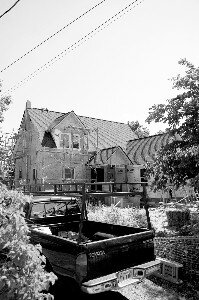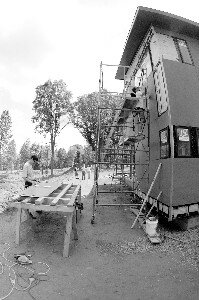COVER- Living large-r: Little house on Little High gets lift

"From the very beginning I didn't really like it," says Suellen Schnyer of the Little High Street house she and her husband, Jonathan, then newlyweds, purchased in 1988 for $67,500.
"We've never had enough room to have company over," says Schnyer, lamenting the cramped kitchen and lack of a dining room, which forced the family of five to eat in the living room. "There were certain things I always wanted in a house," she says, " but I never thought this house could be transformed into what I wanted."
She thought wrong.
A few years ago, the Schnyers decided they'd like to build a custom home– one with all the details Schnyer had dreamed of– a kitchen, living room and dining room, a master bedroom suite– but they hit a roadblock.
"We were completely floored by the price of land," she says. Forced to consider renovations to their existing home, Schnyer realized the possibilites were extensive. Thanks to Charlottesville's booming real estate market (and the fact that they'd finished the basement, doubling their home's size), the 1,700 square foot house would be assessed in 2005 for $242,000. With that heaping pot of equity, the Schnyers realized they wouldn't need to shell out a penny to get exactly what they wanted: a second floor with two extra bedrooms, a new entrance on the first floor, a dining nook, and an extra bedroom in the basement for a total of approximately 3,000 square feet.
Realtor Roger Voisinet says the Schnyers aren't the only ones using equity to raise the roof.
"The idea of expanding and remodeling is more forceful when home prices are going up a lot and interest rates are high," he says. Voisinet says he's considering renovation to the five or so small houses he purchased in the last several years.
"Now, the purchase price is less than the lot values," he says, "so I can afford to consider doing that kind of thing."
A block over on Meriwether Street, Mark Haskins is overseeing a similar project. He and his wife, Alisa Smith, bought a small, rundown house across the street from their primary residence in 2002 for $52,000 and demolished it down to the foundation last year.
"It was a house that was about to fall down," Haskins explains. While the new house will be larger than the old, he says he's focused on quality over quantity.
"We want it to be the antithesis of a McMansion," says Haskins, who is acting as the general contractor and will do much of the actual construction himself.
Like Haskins, Suellen Schnyer says she's happy to be overseeing her family project, but she cautions others who might also consider acting as their own general contractor. It's the equivalent, she's learned, of a full-time job.
"My husband and I are doing it together," says Schnyer, a nurse who works the evening shift while Jonathan works daytime hours. " We're almost spending every spare minute," she adds. "It's like a big baby."
Though they started the project in February, the Schnyers are still months away from enjoying a finished home– the stuccoed exterior will be complete in approximately a month, Schnyer predicts, but the interior may not be done until sometime in fall. Until then, the Schnyers and their three teenagers are living in a studio apartment in the basement, riding out the dust and noise of a construction site.
She acknowledges it's a stressful situation.
"There are actually marriage counselors who specialize in remodeling issues," she laughs.
But she says they're ready to ride through the rough patch.
"We used to own a restaurant, and that was way worse," she says, "so we keep comparing it to that."

Small..
PHOTO BY WILL WALKER

Getting bigger....
PHOTO BY WILL WALKER
Middlepersons: They want to take guesswork out of contracting
Anyone who's come home to mysterious holes in their walls, swarming insects, or a flooded basement knows that the process of selecting reliable contractors can be a project unto itself, and a stressful one at that. Which companies will do the job well– and on time? Which offer the best deal? Two local businesses now aim to take the guesswork out of hiring home contractors.
Lee Cubbage, who operates Home Concierge Services [this is the correct name of the company which appeared in a slightly abbreviated form in our print edition–editor] through Montague Miller & Co. Realtors, says hers is the only company boasting a "real live concierge all day long, five days a week."
Any area homeowner looking for a recommendation for nearly any type of contractor can call Cubbage, who will recommend one of her approximately 50 vendors. The service works, Cubbage says, because it's free to the customer. Vendors pay what Cubbage calls a "nominal" fee to be kept on her list.
Cubbage connects customers with vendors in every niche of the improvement industry including but not limited to landscaping, painting, plumbing, and house cleaning. Once the recommendation is made, Cubbage explains, "I'm sort of out of the equation at that point. But I hover."
Cubbage says many of her clients are families moving into the area and wanting their new home to be ready for them.
"They'd much rather get here and have had the interior painting, the landscaping, all these things done so when the truck arrives they can hit the ground running," Cubbage says. And though she admits the service is a way for Montague Miller to attract new clients, she says the service is open and free to everyone, even those not planning to buy or sell a home in the future.
While Cubbage has offered her services for nearly eight years, she's no longer the only act in town.
The brainchild of Charlottesville entrepreneur Phaedrus Acgtblu, 45Fix is an online business that provides customers with multiple quotes from area contractors.
Acgtblu came up with the idea for the business after spending hours screening contractors for projects in his own home– and realizing he wasn't alone in his frustration.
"The top consumer complaint nationwide is homeowner difficulty in getting home improvement projects arranged and completed," Acgtblu says. His company is "a simple solution that allows customers to go to the internet, load some details about the project, and leave the rest to us with a guarantee that they will be satisfied in the end."
Vendors pay a fee to be included on 45Fix's referral list, but as with The Concierge, customers pay nothing more than the price for the vendor's service.
But some locals believe personal experience– not a middleman– is the best way to find reliable contractors.
"I don't think I would use the service," says Amy Munn. "I'm a longtime Albemarle County resident, and I probably know more than a concierge service for having lived here so long."
Plus, she fears, "There might be a conflict of interest if the contractors pay to be included."
Acgtblu, however, denies the conflict of interest and says 45Fix uses an extensive screening process to qualify contractors– he meets them in person, checks references and insurance, and looks for any legal judgments against them.
"This saves the homeowner from having to do this multiple times over when interviewing contractors," Acgtblu explains. In addition, 45Fix goes a step further than Cubbage's Concierge service, he says, by handling the billing and scheduling, helping ensure the job is done timely and that pricing is fair.
Although 45Fix is his newest venture, Acgtblu has a history of starting successful businesses. As the creator of Vmeals.com, he set up administrative assistants in 30 cities nationwide with access to catered foods from over 800 restaurants and caterers. Acgtblu, under his former name, Kent Schwager, was also the brain behind The Corner Meal Plan, a company offering restaurant meals to students with a swipe card, a concept later expanded to several other American college towns.
"All three of these businesses have a similarity in that they address highly fragmented industries where supply and demand are not efficiently connected," says Acgtblu, who says he changed his name when he got married. "By using the internet as a vehicle to add productivity, and stapling on good old-fashion customer service, we are able to help smooth out what would otherwise be a frustrating process."
Cubbage, however, says she's worried that Acgtblu may have overestimated the demand for this type of service– or underestimated how much work it will take.
"In this day and age, people seem to think [they] can leap that building in a single bound," she says, "even after they've smashed into the fifth floor."
Acgtblu isn't fazed by Cubbage's concern, and says there's room in the market for both. "I think that if she does home improvement and is professional, then it's great," he says.

Lee Cubbage.
PHOTO BY WILL WALKER
#
Corrections: Lee Cubbage's first name was misspelled in a caption, and we also misstated the name of the company; it is Home Concierge Services.
STOA-cism: Design/build team takes up residence
When Zocalo restaurant first opened its doors in January 2004, the transformation was startling. Where its predecessor, Moondance, had been dark and subdued, Zocalo was filled with light wood, newly exposed brick, and high ceilings with visible ductwork. The resulting "industrial aesthetic" was an immediate hit, says Zocalo co-owner Andrew Silver, who says he still hears the same question over and over: Who did the design?
The answer: Mike Savage and Justin Heiser, two young architects from the firm STOA Design & Construction, and as a direct result of their work on Zocalo, they've spent the past nine months building a sprawling contemporary home on a 43-acre parcel in western Albemarle County
"We loved their vision," says Ann Gayhart, who along with partner Marianne Bechtle, admired the restaurant and the unusual materials Heiser and Savage used, including specially finished plywood and textured concrete.
"They're willing to use materials no one else in Charlottesville would," Gayhart explains of the couple's decision to hire STOA after interviewing several traditional architects.
Since Heiser and Savage, both 31, do the design and the actual construction work themselves with a small contracting crew, all of whom have design training, the process is more streamlined than using a separate architect and general contractor, Heiser says. Though this is the first home they've both designed and built, in their commercial projects the concept has saved clients money and allowed for greater flexibility. The same is holding true for a residence, Heiser says.
"Not everything is designed up front," he explains. Rather, the company gets all necessary building permits, but makes certain design changes as they go along. Gayhart says she and Bechtle have been thrilled with the results, and the pair joke that they've stopped even making suggestions. "We know it'll end up looking good," she shrugs with a smile, pointing in particular to a double sided indoor/outdoor fireplace that faces both the family room and the outdoor pool patio. "It's an unbelievable custom job," she says.
Among the unusual characteristics of the 5,500 square-foot, two-story home: concrete board siding, a low or even no maintenance siding that here has been stained a dark gray. The concrete boards, 1/4 inch thick, are cut into various sized squares and rectangles and then must be drilled individually on the home. "It takes a while," Heiser admits.
Inside, the "light industrial aesthetic" continues, with stained concrete floors throughout the first floor, except in in the adjoined kitchen, dining, and family rooms, where bamboo will be laid. Creative storage spaces abound, and on the second floor, three bedrooms and a rec room give the couple's three teens ample space and privacy. Here, Heiser says he will add "character" to the space by using barn track doors rather than standard hinged models.
The first floor master suite opens onto the outdoor swimming pool, but it's the steam shower, and in particular, a custom designed poured concrete "infinity" bathtub that makes the master suite seem even more decadent. With radiant tubing set into the concrete, the multilevel seats will warm while water pours out directly from a hole in the wall, rather than from a traditional faucet.
Though the house won't be finished for a couple of months, Gayhart and Bechtle say they've gotten everything they wanted– and some things they didn't even know they wanted.
"Whatever they come up with is better than what we thought of," adds Bechtle.

Justin Heiser of STOA Design/Build.
PHOTO BY WILL WALKER

The house that STOA built.
PHOTO BY WILL WALKER

Unusual materials make STOA's designs stand out.
PHOTO BY WILL WALKER
Sheltered existence: Experts offer summer tips for home and garden
John Ashcraft
Holistic Pest Solutions
Q: In addition to chirping crickets and croaking frogs, I've recently begun hearing another summertime noise– the dreaded drone of bees in my backyard. What can I do if I have a bee or wasp nest around or in my home?
A: Bees can be a common problem in this area, especially since they're attracted to almost any kind of flower. A lot of stinging insects also like holly trees and will swarm around them, particularly in the spring.
There are several species of bees in the area, but not all of them are dangerous to humans. Cicada killers, solitary ground bees, mud daubers, and honeybees are considered more a nuisance than a threat.
In fact, honeybees are very valuable to beekeepers and should not be eradicated. Usually if you call a local beekeeper and tell him you have a nest, he'll remove the bees for you and be able to use them. Be sure to ask him how to remove the empty nest, though. Without the bees' wings to cool the honey, it will drip and create a sticky mess.
The kinds of bees to watch out for are carpenter bees, who damage exposed wood such as log cabins or any trim that's not painted or sealed. Exercise caution around baldface and European hornets, paper wasps, and yellow jackets, as well. Yellow jackets nest in the ground, and people sometimes hit the nests while mowing the lawn, at which point the insects will attack en masse.
People have been known to try to get rid of yellow jacket nests by pouring gasoline into the hole in the ground. This is a bad idea, since the gasoline can seep into the groundwater, and it won't eradicate the problem because the nests don't lie directly underneath the hole. Instead, you should pour a tablespoon of insecticide into the hole to take care of the problem.
Another mistake people make is attempting to remove on their own a large nest or one that's in the siding of a house. In tricky or serious situations, always call a professional.
Once the bees and nest are removed, seal or cover the hole in the siding or ground. This should take care of your bee problem and ensure that no other uninvited guests take up residence.

John Ashcraft
#
Ben Doyle
A New Look roofing contractors
Q: How do I know when my shingle roof needs work? Can I safely perform my own minor repairs?
A: Roof shingles are often damaged by heat, especially if your home has poor roof ventilation. Your shingles need to be replaced if they start curling up, making the edge of your roof look thicker than normal. Another sign is finding fragments of shingles that have accumulated in your gutters. You may also find that water is slowly saturating through your roof, creating stains on your ceilings.
If you find that you do need to work on your roof, the most important thing to keep in mind is safety. It's best to work in very warm conditions so the glue is pliable, but many people have been injured because the asphalt gets extremely hot, and debris can get under your body and cause you to slip.
It's difficult to replace just a few shingles if the roof is older and the shingles are compressed tightly together. In such a situation, you may have to have the roof entirely replaced by a professional. If the roof's relatively new, however, you may be able to do a partial replacement with a flat bar and utility knife.
All roof shingles will come with specific instructions, but here are the basics steps: start on the shingle above the one you want to replace in order to expose the nails of the shingle you want to replace. The entire shingle should be loose before pulling out the nails. Since the shingles overlap, you'll have to take the nails out of the shingle just above the damaged one.
Pull the damaged shingle out with a flat bar– but go slowly so you don't take off part of the upper one– and slide the new one in, aligning it with the surrounding ones. Nail it on according to the pattern provided, and apply a bead of roofing adhesive under the tabs of the new shingle.
It's a good idea to wear gloves while doing any kind of roof or gutter work. It's easy to fall if you jerk away because something sharp cuts your hand. Consider buying an attachment that secures the ladder to the roof.
#
Corbin Snow
Snow's Garden Center
Q: I love the look of a lush, green lawn, but for some reason mine never quite makes the cut. How can I make my yard the envy of all my neighbors?
A: The biggest concern this time of year is the weather. Due to the extreme temperatures and high humidity, funguses and diseases can invade. The most common fungus is Brown Patch, which, appropriately, shows up as brown patches in the lawn with an irregular circular shape, about 8-12 inches in diameter. You can treat it with a fungicide– Fungonil or Daconil both work.
One big mistake people make is to fertilize their lawns in very warm weather. Don't do it! The high level of nitrogen leads to disease– including Brown Patch– and makes your lawn less drought-resistant.
For example, if a dog pees on your grass and it turns brown, it's because of the high nitrogen content in the urine. If you fertilize in the spring or summer, the sun will react with the nitrogen and burn your lawn. Instead, fertilize in the fall– from September to December.
When the weather cools a bit, aerate and over-seed your lawn. The best seed for this area is tall fescue. At the same time, put down an organic compost topdressing. Bumpercrop is a good one, but the best is Rivanna Gold, which is created by the Rivanna Water and Sewer Authority. It's human waste that's been treated, and it's the absolute best compost out there. We buy it wholesale. They have vast quantities of it. It's safe to handle and put down on your lawn. I swear by it.
It's also important to water and mow appropriately. Mow your grass once a week at a height of no less than three inches, and make sure your blades are sharp to give a crisp cut. If they're not, there will be jagged edges that will leave the lawn susceptible to infestations of insects. Current research shows it's best not to remove clippings– they're returning nutrients back into the soil. Only if it's gotten really long is it a good idea to rake or bag the clippings.
As for watering, your lawn really needs about three-quarters of an inch to an inch per week to make sure it doesn't go into dormancy. It's best for your lawn to receive that water in one or two deep soakings, rather than many light sprinkles.
In the end, a perfect lawn starts with the soil. If you have good soil, you can have the most beautiful, lush, green perfect lawn and make your neighbors envious.
Got a question for an expert? Call the Hook at 295-8700 x 236.

Corbin Snow, president of Snow's Garden Center
PHOTO BY HAWES SPENCER
#
Dan Foster
Foster's Pest Control
Q: My children's playroom is in our partially finished basement, and I've noticed an ever-increasing number of spiders down there– some of them huge. What can I do to get rid of them, and do I need to be worried about their bites?–Arachnophobic
A: Just like flowers, insects are in full bloom right now, and
All spiders have venom, but the only two around here that will cause a serious reaction in most people are the brown recluse and the black widow.
How do you know if you're seeing a black widow? They're shiny black spiders that get to be a decent size– as big as a dime sometimes. The red hourglass on the underside is a good sign. You could use a pencil to turn the spider over to check. If in question, it's best to leave it alone and have a professional look at it.
It's more difficult to identify the brown recluse. The head is violin shaped, but I've only seen a couple. The good news is that they don't commonly come into contact with people. True to their name, they like very dark, damp places with still air. Crawl spaces and woodpiles are favorite hiding spots, so if you're working around wood, wear gloves.
The big hairy spiders in your basement are likely wolf spiders, which are pretty harmless. They're a spider that will make you hurt yourself, versus them hurting you. They're very large– often longer than an inch– fast, unpredictable and they can jump and startle people.
Some things that may help to reduce the number of spiders is to pick up clutter, where lots of insects like to hide. And wipe down cobwebs once in a while as a preventive measure. That goes for the outside too. Insects commonly called "granddaddy longlegs" are not true spiders. They actually prey on spiders, so you might be happy to see a few of them lurking about.
Except for the brown recluse and black widow, spiders are harmless. The easiest thing is to just relocate them– pick them up in a tissue or on a piece of paper and drop them outside. If you have a huge infestation and think you absolutely must get rid of them, I recommend a pesticide around the exterior of the house. I don't have a lot of faith in aerosols– they're potent, but they don't last long. And while some of the products sold at local hardware stores aren't too bad, I'm not sure they're worth the expense.

Dan Foster of Foster's Pest Control
PHOTO BY HAWES SPENCER
#
Tom Kavounas
President of Albemarle Heating & Air
Q: The heat this summer is unbearable. What can I do to make sure my air conditioning unit is working properly?–Dazed and Confused
A: Since air conditioning units are often neglected, the air filters in front of the equipment can capture big particles of dust and dirt that will block up the coil. As a result, the unit overheats, which is dangerous and causes your energy bill to go up. The system won't cool as well, and it will run longer than normal.
The solution is regular maintenance. You should call in a professional once every six months. He'll make sure the filter's unclogged, there's no debris in or around the system, the thermostat's working, and the drain line isn't stopped up. One visit will typically cost about $80, but often there are deals and discounts for preferred customers.
The occasional visit from a professional does not mean a homeowner can ignore the system the other 363 days of the year. The filter needs to be changed every 30 days. A dirty filter can increase energy bills $20-$30 a month.
If you have an outdoor unit, it should be kept free of debris. Trim any surrounding shrubbery, keeping at least two feet of clearance around the unit and a minimum of six feet above. Additionally, the unit should be at least four inches off the ground, on a pad and supported by feet.
People have major misconceptions when it comes to operating air systems. A lot of people will keep the thermostat at 72, change it to 80 when they're at work, and then come home and turn it back to 72. But it's actually cheaper to leave it at a comfort level even when you're gone. If you're interested in saving money, the best thing to do is to keep the temperature a degree or two higher than your normal comfort temperature all the time.
Also check your thermostat to make sure it's functioning properly. If it's mercury, see that it's mounted to the wall correctly, or it may read wrong. Be sure to have it calibrated when the air conditioning unit is serviced.
Larry Sambrook
Certified Indoor Environmentalist of Airflow Diagnostics Institute, LLC
Q: I read all about mold problems in a recent issue of The Hook. What can I do to safeguard my own house against moisture intrusion? How can I tell if I already have a problem?–Dampened Spirit
A: Moisture intrusion is a year-round problem that can strike anywhere, but it's typically worse in the summer because of the increased humidity.
If you have a crawl space, the best way to prevent moisture problems is to make sure it's properly protected from water. The crawl space is the space between the ground and your house. (Houses with basements don't have one.) The crawl space should contain overlapping layers of plastic, taped at the seams and glued to the wall of the house.
Moisture can invade your home whenever there's dirt in the crawl space (which is almost always). For an average 1200-sq.-ft. house, about 13 gallons of moisture vapor per day seep up from the ground, no matter the house's location. The moisture in the crawl space then gets into wood, causing mold and wood deterioration.
Another element to consider when you're dealing with moisture intrusion is poor heating and air conditioning. These air systems have supplies and returns. Supplies provide the cool air coming into the house, and returns push the inner air out. Without enough returns, the house will gradually pull humidity in through the walls. A homeowner should have a return in every room, with the exception of the kitchen and the bathroom.
You can tell if you have a moisture intrusion problem if the air inside your house feels damp or if you spot any mold growth. Good places to check are the grilles on the air vents of your home and the walls of the bathroom.
If you've confirmed that you have a mold problem and you're unable to remedy it with the suggestions listed above, it's time to call a professional. Although costs vary depending on the size of the house and the seriousness of the problem, a professional should be able to perform a whole house dehumidification for a 2500-sq.-ft. house for $4000-4500. This procedure involves using air to push out on the walls of the house from the inside. Ideally, a building should be positively pressurized or neutral so that it's not sucking humidity through the walls.

Larry Sambrook of Airflow Diagnostics Institute
PHOTO BY HAWES SPENCER
#
Repointing pointers
Bill Mack
Allied Concrete
Q. After a long summer, our brick is wearing, and pieces are falling out. How do I repoint the weathered bricks?
A. The best way to repoint at home is with a trowel and a tuck-point blade. The trowel holds the mortar, and the tuck point pushes the mortar into the aging joint. Just push the mortar into that joint. If you want an example, go to quikrete.com and click on Do-It-Yourself projects.
To choose the right mortar, take a sample of your mortar to a concrete or brick shop. There are pre-mixed mortars or colored mortars. For the colorCXZs, just add sand to the solution. The most difficult task is to identify your color and then find the closest match– the matching process depends on the extent of brick weathering and aging.
Also, the age of the brick helps to determine the strength of the mortar you should use. If the brick is over 50 years old, you have to begin to use softer mortars– just buy mortar with higher lime content. With aging, the bricks may shrink, and stronger mortars may damage the brick even more.
When repointing with mortar, you usually have about two hours to work. Make sure you have above freezing temperatures and dry conditions. The mortar takes about three to four hours to dry after application.
Many homeowners will be dissatisfied when duplicating the mortar colors. But mortars age and weather– you'll never match mortar exactly, and the aging process makes it even more complicated. Even with professionals, you can usually distinguish new mortar from the original color.
Be sure to evaluate how much of the wall you want to repoint. Depending on the extent of the weathering, you may have to replace whole sections of the wall, but tuck-pointing the joint usually works for minor weather repairs.
Oftentimes you notice the different color mortars, but don't get discouraged – practice before you repoint, and as you do more, it gets easier and easier.

Bill Mack of Allied Concrete
PHOTO BY HAWES SPENCER
#
David Killmeyer
Stafford Home Products
Q: We bought an old house in Belmont, and we've been freezing this winter! Now I'm worried about keeping it cool this summer! How can I insulate my house better?
A: Re-insulation is something we do quite a bit. Most houses that are relatively new, from the late ‘70s to 1980s on, don't require it because they were built to code, but older neighborhoods like Belmont have plenty of houses with no insulation whatsoever.
Belmont has become popular recently, with people buying the houses, fixing them up by repainting, reroofing, or making other cosmetic improvements, and then flipping them without thinking of insulation upgrades.
Homeowners can do something called drill and fill. Drill a two-inch hole in each stud bay cavity and fill it with something called cellulous, which is made up of recycled newspaper. This seems to work best. The insulation itself comes wrapped in plastic like a hay bale, and you need a machine to break it up so it fits through a hose to inject it into the wall. Of course, this only works if the walls have no insulation to begin with.
With some older houses, the insulation behind the wall may have fallen down, in which case it's possible to inject cellulous. Otherwise, it's necessary to remove the old insulation, which most people find cost prohibitive.
People should be aware that this procedure creates an enormous amount of dust. I always try to prepare people for this, but nothing seems to do it justice. Fortunately, the dust settles pretty quickly and can be cleaned up easily with a shop-vac. Still, it tends to linger for some time. If you have central air, the situation is a little better, since the system itself will help clear the dust out faster.

David Killmeyer
PHOTO BY DAVE MCNAIR
#